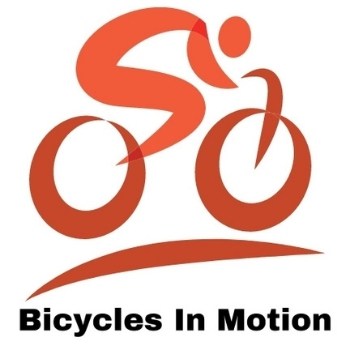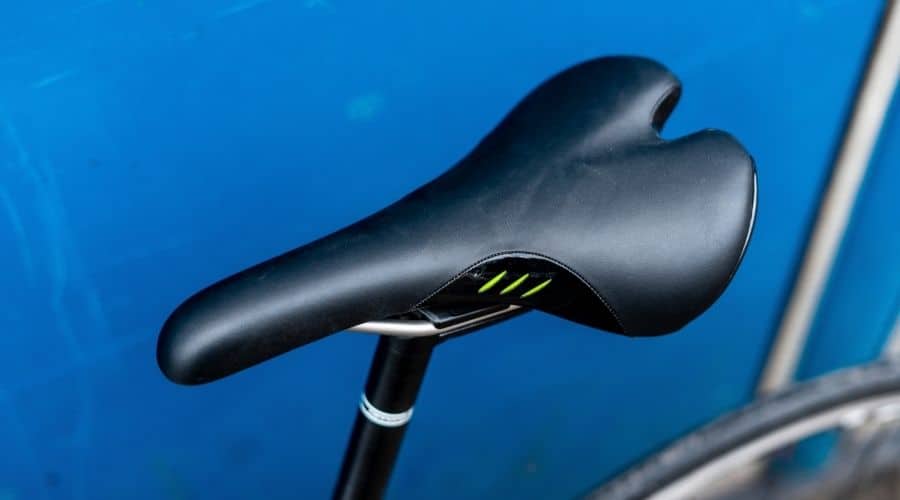Road bike seats are notorious for being hard and small. Unless you’re riding a cruiser or touring style bike, then your bike seat probably isn’t meant to hold your entire body weight, or at least not for long.
A road bike seat is there to rest against, not to sit on like a chair. Why are road bike seats so hard?
A road bike seat is so hard because the rigid plastic is there to only support your ischium, the bones at the base of your pelvis, and not your whole-body weight. The rigidity helps you maintain the proper bicycling posture as you push the pedal down to prevent chafing and keeps the distance between your legs and the pedals constant.
Recommended Gear
To see all of my up-to-date recommendations for bikes and cycling gear, check out this resource that I made for you!
Table of Contents
Why Are Road Bike Seats So Uncomfortable
Road bike seats aren’t meant to feel like a couch cushion, and most people find them uncomfortable.
If you’re pressing all your weight down onto the hard, molded plastic or leather, then you’re not distributing your weight correctly, and it feels unpleasant.
Your road bike seat is for taking some of the pressure from your pelvis and supporting your ‘sit bones,’ the ischium.
Typically road bike seats are nylon or another hard plastic, but sometimes they contain carbon fiber. The carbon isn’t meant to be harder or softer, but lightweight and incredibly durable.
Over that, there may be a cover made of a thin layer of fabric. Although they’re less common on road bikes, some seats are thick, molded leather instead.
Regardless of the material, road bike seats all follow the same general shape and size. These small, narrow seats should be set high enough to keep riders in a spot where their legs reach full extension with every pedal.
Having the proper extension lets you maximize your energy-to-bicycle transfer, so you move more efficiently.
You may also notice that there’s a gap in the middle of the seat. This hole helps keep air flowing to the rider as they move, and it removes a little material that makes the saddle even lighter.
Road bikes are often used for racing or endurance, so anything that reduces the rider’s burden helps you get where you’re going faster and with less fatigue.
Why Do Road Bikes Have Hard Seats
Hard seats may seem almost mean when you first start using them. However, the rigid road bike seat is made that way on purpose, and it’s actually doing your body a favor.
To push your leg downward effectively, you need leverage. You are getting the most out of your muscle use by providing a solid, unyielding surface to brace your sit bones as you drive your knee and foot downward.
Additionally, the materials that make your road bike seat hard also make it last. You don’t need to worry about soft foam padding breaking down or added bulk weighing you down.
Sure, soft, padded, and cushioned seats feel more comfortable, and a broader base will support more of your weight.
Unfortunately, when riding a road bike for speed, both of those qualities are a detriment, and they’ll slow you down.
The bicycle types with wide, softer seats are for prolonged comfortable sitting. These bikes have higher handlebar rise and an upright sitting position for leisure riding.
A cruiser or touring bike is meant to move at a measured pace for fun and casual commuting.
By comparison, your road bike has negative rise or drop handlebars and a high, narrow, small, hard seat to move your body into the best aerodynamic position to gain and maintain speed.
Different bicycle styles serve other purposes.
Why Are Road Bike Saddles So Narrow
A narrow seat is a must for your road bike. I already explained why you don’t want added weight but having additional girth and bulk can cause other issues for road bike riders.
When you pedal, you move your legs in a particular pattern, fast and repetitive. Doing this will cause friction and, with a broader nose on your bike saddle, it could cause chaffing.
Anyone who has ever had a blister can tell you that extreme chaffing is terrible news. Not only is it uncomfortable, but it can lead to infections.
Bacteria spreads quickly when moving and sweating, which is a normal part of bike riding.
If you were to look at the shape of your body in a proper road-bike riding stance, you would see where a narrow saddle fits in.
The shape and size of these saddles are made to fit the available space without causing any added pressure, friction, or issues to slow the body down or impede its efficient pedaling.
Sitting wrong or using a too-large seat can lead to pudendal nerve damage and pain.
According to Harvard Health, “Sitting on a bicycle seat puts pressure on the perineum, compressing those vital nerves and arteries. This can lead to loss of sensation and other problems.”
Why Are Road Bike Seats So High
When you ride a road bike, efficiency is everything. To get the most out of your pedaling and transfer as much energy as possible from your body to the wheels, you need your leg to reach almost full extension with every downstroke.
To accomplish this, you’ll have to set your seat high.
In addition to being more efficient, the correct pedal strokes help to prevent injuries.
Moving your knee and ankle around in shorter circles without the full extension can cause unnecessary damage over time. Riding should be enjoyable, not painful.
Are you unsure where to set your bicycle seat? No one expects you to be an expert, especially if you’re new to riding.
I recommend checking out this fantastic video from Global Cycling Network to learn how high you need to set your seat.
How Can I Make My Road Bike Seat More Comfortable
If your road bike seat hurts or is exceptionally uncomfortable, you probably need to make some adjustments.
It’s not a seat issue, but rather a problem with how you’re riding and your posture that causes pain. Using your bike correctly is a lot easier when it’s set upright.
I’ve collected a quick list of adjustments so you can troubleshoot your bike seat discomfort quickly:
- Bar Tape and Tire Pressure – Although taping your handlebars and reducing the air in your tires may seem unrelated to seat feel, these are the simplest ways to help minimize discomfort over a bumpy road. Unlike your seat, it’s OK to add padding to handlebars. Likewise, lowering tire pressure adds a little more cushion to your connection with the ground, and doing both makes the whole riding experience fee less bumpy.
- Match Saddle Shape – If your bike set is rubbing regardless of your position, height adjustments, etc., then you probably need a new seat. Our bodies are individual, and the best seat for one rider doesn’t suit every rider.
- Check Your Rise – Make sure that your handlebars and seat are both adjusted correctly. A few millimeters up or down can make a surprising difference in how your whole ride feels.
- Adjust Your Reach – Having your hands the proper distance in front of your body will help you sit properly on your bike seat. Getting the correct posture and weight distribution is the difference between every ride causing pain and injuries and having an enjoyable ride.
Helpful Tips To Know About Why Road Bike Seats Are So Hard
A rigid road bike seat is not a hardship; in fact, it is there to help you ride properly. Without these small, unyielding seats, you could suffer injuries, and it would certainly slow you down.
Here are more helpful tips o know about why road bike seats are so hard.
- Did you know you can adjust your saddle angle? If all else fails, try tipping the nose of your seat up or down for a more comfortable ride.
- Using your road bicycle seat correctly is vital. Otherwise, it can cause pain and nerve damage. Bad posture, friction, and pressure can also contribute to numbness and even long-term nerve damage. For male cyclists, bad bike posture and too much pressure can lead to erectile dysfunction.
- Padded bicycle shorts may seem like a sensible solution, but they’re not. Adding pads to your pants instead of your seat gives you the same result, which s to add friction and pressure while cycling.
Final Thoughts
Road bike seats are small and hard on purpose. The style and firmness of these bike seats help riders transfer energy from their bodies to the wheels more efficiently.
Moreover, it promotes proper posture and enables you to become more aerodynamic.
Best of all, a hard bike seat can aid in preventing injuries when appropriately used, but the other side of that is that using your hard road bike seat wrong can cause harm.
It is essential to use correct posture and adjust all the parts of your bike, so you sit right in on your bicycle’s saddle.

